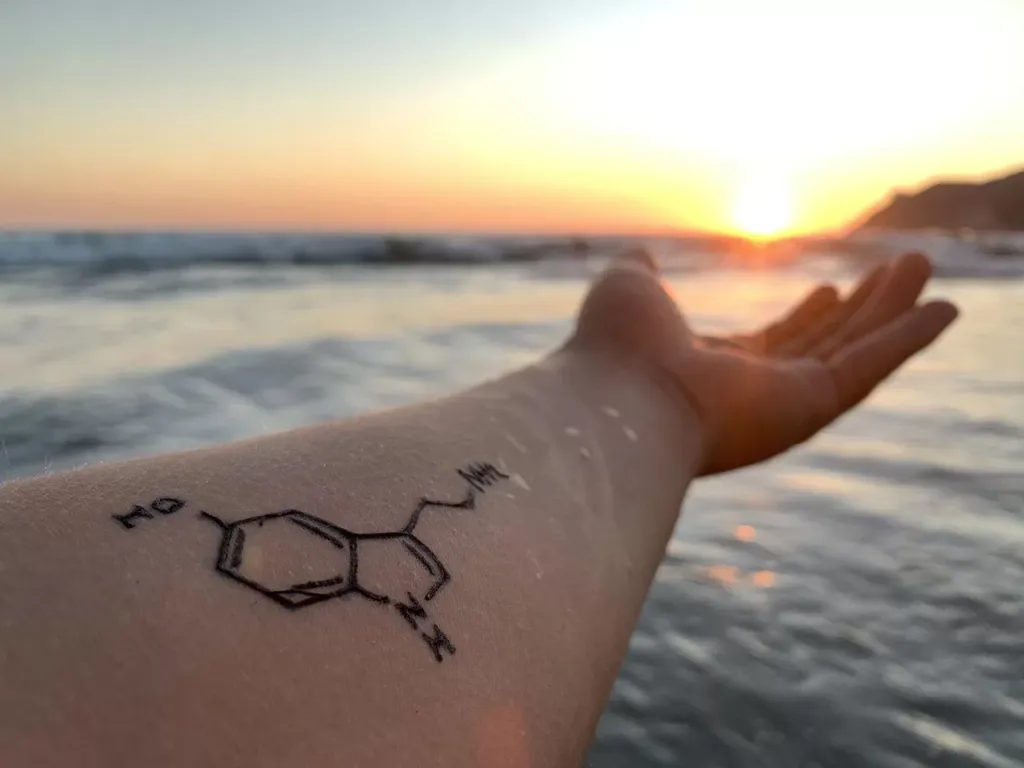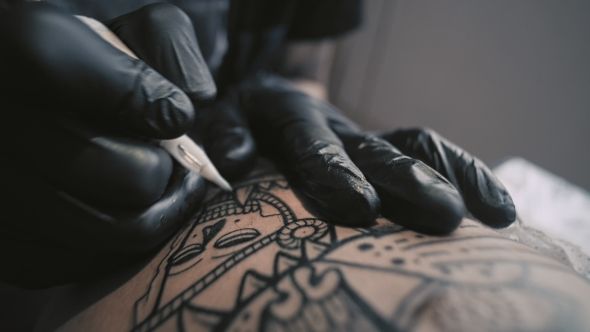Going to the beach and viewing some gorgeous tattoos there may inspire you to add or begin your piece of body art. Excellent concept, but perhaps it is the wrong time and place. Swimming And Tattoos, not the best combo. This is not the time to get a fresh tattoo unless he plans to spend the remainder of his vacation in the shade and out of the water. This is the reason. Read more about getting a tattoo in pregnancy here.
Tattoos and Sun
The location of your new tattoo is susceptible to sunburn, UV rays cause fresh ink to fade, and sunscreen is not recommended for new tattoos. Cool tattoos and sun vacations can not go together.
Tattoos and Water
You’ve spent a lifetime on body decorating. Therefore you don’t want to wind up with something patchwork and faded. New tattoos are delicate beings, and immersing them in water may cause the ink to bleed and fade. Swimming is quite hard for keeping a tattoo dry. So, how long can you swim after having a tattoo? Not for at least two or three weeks, and you may have to wait longer if the tattoo is enormous. A public pool is likely to contain chlorine, which could irritate a new tattoo. The chances of some nasty bacteria in the pool, regardless of the chlorine content, are pretty high, increasing the chance of infection.

Also, keeping the uncured tattoo submerged for a long time will increase the risk of diluting the ink and reducing sharpness and vibrancy. Most indoor and outdoor pools use a powerful chemical to eliminate microorganisms. Chlorine is the most often utilized chemical in public pools. This is a foe of fresh tattoos, and we must avoid getting into contact with it throughout the healing process. This chemical can irritate the tattoo before it heals, causing it to become excessively dry and flaky. It can also make the region irritable and produce a variety of other ailments, such as skin rashes and red pimples. Even if the pool does not utilize chlorine or any other chemicals, it is still best to avoid it. These pools are unlikely to have any prophylactic measures to protect swimmers from illness, making the tattoo susceptible to infection.
Tattoos and Skin Irritation
The skin around a fresh tattoo is especially prone to irritation, which can develop into dermatitis. As a result, it is best to avoid contact with known skin irritants. People frequently inquire, ‘How long after a tattoo can you swim in chlorine?’Given that chlorinated water is effectively diluted bleach, it’s not surprising that it might hurt the fragile skin around the tattoo location.
Tattoo and Infections
Consider your tattoo spot to be an open wound. Because that is just what it is. The damage is minor, but they have undermined the organ’s integrity, which is meant to be a barrier between you and the outside world. Swimming in the water with new tattoos is, therefore, an extremely bad idea. Even in locations where the sea is clean and clear, there will be millions of bacteria you do not want to infiltrate your tattoo site. One potential is that you could get a superficial skin infection resulting in a permanent scar. More critically, if the incorrect bacterium enters your circulation, you might get a systemic illness. At best, this will spoil your holiday; at worst, it may jeopardize your life.

A Design For a Lifetime
It all seems painful, but if you want the nicest tattoo possible, you must take adequate care of it in the first few days. Here’s a summary of the important points: Is it safe to swim after having a tattoo? Of course, yes. Just let it heal completely beforehand. How can you keep a new tattoo safe when swimming? You just cannot! You can protect a tattoo from water in the shower and, with a little effort, even in the bath, but what about when swimming? It is not a ray of hope! How long can you avoid swimming after getting a tattoo? You must wait at least two weeks, and some experts advise three.
In general, the larger the tattoo, the longer it takes to heal. If the wound is still crusty, scaly, itchy, or tingly, don’t go back in the water. That’s all there is to it. If your summer holiday plans include snorkeling with Koox Diving in Playa del Carmen or any other activity that entails exposure to the sun or sea, put off getting that new tattoo until you return. That way, you’ll be able to enjoy your vacation to the fullest while increasing your chances of creating a piece of leather art that will turn heads for all the right reasons.
How to waterproof a tattoo for swimming
If you have a fresh tattoo, your skin is still uncomfortable and delicate, much like an open wound. So, ideally, you should only get wet while cleaning the area surrounding it or having a shower. Specialists recommend avoiding any aquatic activities until the skin recovers. However, there may be times when swimming is absolutely important at this period. Perhaps you are undergoing physical treatment or rehab or are dealing with an emergency. Whatever the cause, you’ll be relieved to discover that there are some solutions. Wrapping the tattoo in plastic wrap is one approach, as is sealing it with a medical sealer.

1. Wrap the tattoo in plastic wrap
Although it may appear strange, tattoo artists advocate covering the ink with plastic wrap, such as Saran Wrap. It’s ideal for the first few nights of sleep after getting new ink, and it’s also a simple method to keep tattoos clean and dry. Remember first to apply a thin coating of ointment or a moderate moisturizer. Then, place a layer of gauze or a paper towel on top. They provide an airtight barrier, limiting the amount of moisture that may enter and harm your skin. In brief, it is an excellent approach to lower the danger of infection while also assisting in the healing process. The less plastic wrap you use to cover your tattoo, the better. Remember that your skin has to breathe to recover to normal, which it cannot do if it is covered.
2. Seal the plastic with a medical sealant
A medical sealant is a surgical adhesive that surgeons use to close wounds. As a result, they are an easy solution for waterproofing fresh tattoos. SkinLock is a well-known brand among tattoo artists. It is simple to use, and the greatest part is that it works in 30 seconds or less, which is rather quick. For even coverage, use 3-4 applications each day. The sealant will then flake off on its own after around 7-10 days. This should give the skin time to heal while preserving the tattoo’s integrity.

3. Safer alternatives to Vaseline
Vaseline, or Vaseline, should not be used as part of your tattoo aftercare. On the one hand, it restricts air movement and traps moisture. It also retains dirt and bacteria, which can irritate the skin. It can, for example, do more harm than good to fresh tattoos. The good news is that there are other alternatives to using Vaseline to waterproof your leather work, including those listed below:
- The oil of coconut
- chocolate butter
- cocoa butter
- Skin cream is designed exclusively for tattoo care.
- Skin moisturizer with no alcohol or smell, such as Eucerin or Lubriderm
- After gently washing and drying your skin, use any of these replacements.
- Then, 3-4 times daily, apply a thin coating to the tattoo.

4. After swimming, take care of your tattoo right away.
Assume you couldn’t help yourself and had to go swimming. What should you do next to safeguard your ink while also keeping your skin healthy and free of inflammation? Assume you covered your tattoo with a waterproof bandage or bandage for the sake of argument. Saniderm, a waterproof adhesive medical bandage for tattoos, is one of our faves. It’s lightweight, breathable, and has various roll and sheet sizes for increased convenience. Remember that the longer the tattoo is concealed, the longer it will take to heal. As a result, remove the bandage when you come out of the water.
Rinse and pat dry the dressing with lukewarm water. Then, carefully peel it off and rinse your skin with water and a light soap or antibacterial wash. Finally, pat your skin completely dry with a clean, soft cloth. Apply a healing ointment or skin cream as a final precaution to decrease skin inflammation. They can also aid with preserving the pattern and color of your tattoo.
